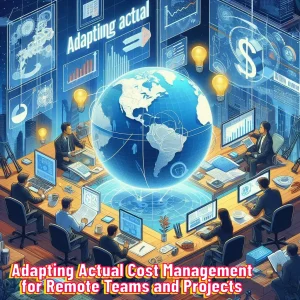To find out how Artificial Intelligence is changing the Project Management landscape, you may enjoy reading this article https://www.shaunstoltz.com/did-artificial-intelligence-just-change-everything-about-project-management/
I. Introduction
In a world where businesses and organizations are driven by projects, the importance of effective project governance cannot be overstated. Projects, be it small or large, require careful coordination, clear communication, and defined roles and responsibilities to meet their objectives successfully. Yet, one of the most common challenges faced by project managers and teams worldwide is the lack of streamlined governance, leading to miscommunication, role ambiguity, and ultimately, project failure.
So, what can be done to mitigate these challenges and pave the way for efficient project governance? The answer lies in an often-underrated yet powerful tool known as the RACI matrix.
The RACI matrix, an acronym for Responsible, Accountable, Consulted, and Informed, is a straightforward and highly effective tool for defining roles and responsibilities in a project. By assigning these four categories to tasks and decisions within a project, teams can drastically enhance their communication, reduce overlapping responsibilities, and ensure a smooth, well-governed project lifecycle.
In this blog post, we will delve deep into the RACI matrix and its four integral components. We’ll explore how it can be used to bring clarity and order to your projects, ensuring they are well-governed, effectively communicated, and steered towards success. Whether you’re a seasoned project manager or a newcomer to the field, this guide will provide invaluable insights into how you can utilize the RACI matrix to streamline your project governance.
Stay with us as we unpack the power of RACI, one component at a time. Let’s dive in.
II. Understanding the RACI Matrix
Before we delve into the specifics of the RACI matrix, it’s essential to understand what it is and why it holds such a critical place in project management.
The RACI matrix is a responsibility assignment matrix (RAM), a tool that is widely used in project management and organizational structures to delineate roles and responsibilities. RACI is an acronym that stands for Responsible, Accountable, Consulted, and Informed, each playing a distinct role in task and decision ownership.
The concept of the RACI matrix isn’t a new one. It has roots that trace back to the middle of the 20th century, originally designed to simplify and clarify roles and responsibilities within complex organizational structures and projects. Despite its age, the RACI matrix has stood the test of time, proving its worth in the modern business landscape.
But why is the RACI matrix so enduring and relevant even today? The answer lies in its inherent simplicity and effectiveness. The RACI matrix is straightforward, easy to use, and it addresses one of the most persistent challenges in project management – defining and assigning clear roles and responsibilities.
By using the RACI matrix, project managers and teams can ensure that everyone knows exactly what they need to do, who they need to consult, and who needs to be informed about the decisions and progress. This clarity reduces the potential for conflict, misunderstanding, and inefficiency, thereby improving project outcomes.
In the following sections, we’ll break down each component of the RACI matrix, highlighting how they contribute to streamlined project governance and improved communication. So, whether you’re leading a team, a part of one, or simply interested in project management, keep reading to discover the transformative power of the RACI matrix.
III. The 4 Components of the RACI Matrix
Now that we have a foundational understanding of what the RACI matrix is and its significance in project management, it’s time to delve into the core of this powerful tool – its four components. These components, when correctly applied, can transform the way your project team operates, leading to better outcomes and a smoother workflow. Let’s explore each one in detail.
1. Responsible
The first component, Responsible, pertains to the individual or team members who are entrusted with executing the tasks. They are the doers, the ones who roll up their sleeves and get the work done. It’s crucial to remember that there could be multiple individuals or teams who are Responsible for different tasks in a project. This clarity ensures everyone knows exactly what their job is, eliminating confusion and fostering efficiency.
2. Accountable
Next, we have Accountable, often the most critical role in the RACI matrix. The Accountable individual is the one who owns the outcome. They are the decision-makers, the ones who have the final say. It’s important to note that, while there could be many Responsible individuals in a project, there should ideally be only one Accountable person per task. This prevents decision-making chaos and ensures that there’s clear ownership of results.
3. Consulted
The third component is Consulted. These are the subject matter experts, those whose opinions are sought out before decisions or actions are taken. They provide the necessary advice, guidance, or approval to the Responsible and Accountable individuals. Typically, these are people with significant experience or knowledge relevant to the task at hand. Their role is crucial to ensuring the quality and accuracy of the work.
4. Informed
Finally, we have the Informed. This group needs to be updated on the progress or decisions but is not actively involved in the execution or decision-making process. They need to be kept in the loop to ensure transparency and clear communication across the project team. This could include stakeholders, higher management, or other teams that are indirectly affected by the project’s outcomes.
These four roles form the pillars of the RACI matrix, providing a clear, structured approach to defining roles and responsibilities within your project. In the next section, we’ll delve deeper into how each component contributes to effective project governance, and how their interplay can lead to improved communication and successful project outcomes.
IV. The Role of Each Component in Project Governance
Now that we have a solid understanding of the four components of the RACI matrix, it’s time to dive deeper into the pivotal role they play in project governance. Each component is like a cog in a well-oiled machine, working together to ensure your project runs smoothly and efficiently.
1. The Role of the ‘Responsible’ in Task Execution
The ‘Responsible’ forms the backbone of any project. They are the doers, the executors, the ones who take a task from inception to completion. By clearly defining who is responsible for each task, you eliminate ambiguity and empower your team members to take ownership of their work. This not only streamlines task execution but also fosters a sense of accountability, driving team members to deliver their best.
2. The Role of the ‘Accountable’ in Ultimate Ownership and Decision Making
The ‘Accountable’ is like the captain of the ship, steering the project towards its objectives. They are the decision-makers, the ones who have the final say. By establishing a single point of accountability for each task or decision, you avoid the pitfalls of too many cooks spoiling the broth. Having one accountable individual ensures that there is no shirking of responsibility or passing the buck, leading to better decision-making and stronger project outcomes.
3. The Role of the ‘Consulted’ in Providing Inputs and Expertise
The ‘Consulted’ are the guiding lights of your project. They are the subject matter experts whose inputs and advice are sought before any critical decisions or actions. By identifying and involving these individuals at the right stages, you leverage their expertise effectively and ensure that the project benefits from their knowledge. This not only enhances the quality of your outcomes but also prevents costly mistakes and oversights.
4. The Role of the ‘Informed’ in Maintaining Transparency and Communication
Last but not least, the ‘Informed’ play a crucial role in maintaining transparency and fostering effective communication. These individuals may not be directly involved in the execution or decision-making, but they need to stay updated on the project’s progress. By keeping them in the loop, you ensure that all stakeholders are aware of what’s happening, leading to better alignment, fewer surprises, and stronger buy-in.
In essence, each component of the RACI matrix plays a distinct and crucial role in project governance. They ensure that tasks and decisions are effectively managed, roles and responsibilities are clearly defined, and communication is transparent and timely. In the following sections, we’ll delve into how you can implement the RACI matrix in your organization and the benefits you stand to gain from it. So, stay with us as we continue to explore the power of RACI in streamlining project governance.
V. Implementing the RACI Matrix in Your Organization
With a robust understanding of the four components of the RACI matrix and their roles in project governance, you’re probably wondering, “How can I implement this in my organization?” The good news is that integrating the RACI matrix into your project management processes is a straightforward task, and we’re here to guide you through it.
1. Identify All Tasks and Decisions
The first step in implementing the RACI matrix is to outline all the tasks, decisions, and key activities that need to be completed for your project. This could range from minor tasks to major decisions that could impact the project’s direction. Be as thorough as possible – the more comprehensive your list, the more effective your RACI matrix will be.
2. Determine the Participants
Next, identify all the individuals or teams who will be participating in your project. This could include team members, stakeholders, department heads, and anyone else who plays a role in your project’s success.
3. Assign the Roles
Now comes the most critical part: assigning the RACI roles. For each task or decision on your list, determine who is Responsible, Accountable, Consulted, and Informed. Remember, there can be multiple Responsible individuals, but ideally, only one Accountable person for each task. Be sure to involve your team in this process to ensure everyone understands and agrees with their roles.
4. Review and Refine
Once you’ve filled out your RACI matrix, review it with your team. This is an excellent opportunity to clarify any confusion, adjust assignments as necessary, and ensure everyone is on the same page. Don’t be afraid to refine your matrix as your project evolves – the RACI matrix is a living document that should adapt to your project’s needs.
5. Communicate and Implement
Finally, once everyone agrees with the RACI assignments, it’s time to communicate and implement. Make sure the finalized RACI matrix is accessible to everyone involved in the project. This transparency will ensure everyone knows their role and responsibilities, leading to better communication and collaboration.
Implementing the RACI matrix can streamline your project governance, improve communication, and enhance overall project success. In the following sections, we’ll explore the benefits of the RACI matrix and how to avoid common pitfalls when using it. Stay tuned as we continue our journey into the world of effective project governance.
VI. Benefits of Using the RACI Matrix for Project Governance
Having explored the core components of the RACI matrix and how to implement it in your organization, let’s take a moment to delve into the manifold benefits of this powerful tool. The RACI matrix, when used effectively, can become a game-changer for project governance, transforming the way your teams communicate, collaborate, and deliver results.
1. Improved Communication
One of the most significant advantages of the RACI matrix is its ability to enhance communication within your project team. By clearly outlining who needs to be kept informed and who needs to be consulted before making a decision, the RACI matrix ensures that communication flows smoothly and effectively. This eliminates misunderstandings, miscommunication, and the resultant delays, enhancing the overall efficiency of your project.
2. Clarifies Roles and Responsibilities
The RACI matrix brings absolute clarity to roles and responsibilities within a project. It clearly demarcates who is responsible for executing a task, who is accountable for the results, who needs to be consulted, and who needs to be informed. This clarity not only ensures that everyone knows exactly what they need to do but also eliminates the possibility of tasks falling through the cracks.
3. Reduces Overlap and Potential for Conflict
Role ambiguity and overlap can lead to confusion, wasted effort, and even conflict within a project team. The RACI matrix, by clearly defining roles and responsibilities, effectively eliminates these issues. It ensures that each person knows their role and boundaries, reducing the potential for overlap and conflict.
4. Streamlines Decision Making
The RACI matrix simplifies and streamlines decision-making processes. By specifying who is accountable for each decision, it ensures that there is no confusion or delay when it comes to making critical decisions. This leads to faster, more efficient decision-making, which is crucial for the successful execution of a project.
5. Enhances Accountability and Ownership
Finally, the RACI matrix promotes a culture of accountability and ownership. By clearly assigning responsibility and accountability, it encourages individuals to take ownership of their tasks and decisions, fostering a sense of responsibility and commitment. This not only improves task execution but also enhances the overall performance of the team.
In essence, the RACI matrix is a powerful tool that can dramatically improve the governance of your projects. It fosters clear communication, streamlines decision-making, reduces conflict, and enhances accountability, leading to successful project outcomes. In the next section, we will take a look at a real-life case study of the RACI matrix in action. Stay with us to see the transformative power of RACI in practice.
VII. Common Pitfalls and How to Avoid Them
While the RACI matrix is a powerful tool for streamlining project governance, like any tool, its effectiveness is determined by how well it’s used. There are common pitfalls that organizations can fall into when implementing the RACI matrix. Understanding these challenges and knowing how to avoid them is crucial to leveraging the full potential of the RACI matrix. Let’s explore some of these common mistakes and best practices to avoid them.
1. Overcomplicating the RACI Matrix
One common pitfall is overcomplicating the RACI matrix by trying to include every minor task or decision. This can make the matrix confusing and unwieldy, defeating its purpose of simplifying roles and responsibilities.
Best Practice: Focus on key tasks and decisions that significantly impact your project’s outcomes. The RACI matrix is meant to be a high-level tool that provides clarity, not an exhaustive list of every minute task.
2. Multiple Accountabilities
Another common mistake is having multiple accountabilities for a single task or decision. This can lead to confusion, duplicated efforts, and accountability dilution.
Best Practice: Remember the golden rule: there should be only one ‘Accountable’ per task or decision. This ensures clear ownership and effective decision-making.
3. Ignoring the ‘Consulted’ and ‘Informed’
Often, the ‘Consulted’ and ‘Informed’ roles are overlooked or not given due importance. This can lead to a lack of transparency and missed opportunities for valuable input.
Best Practice: Recognize the importance of these roles in maintaining effective communication and leveraging expertise. Ensure that relevant stakeholders are kept in the loop and that expert advice is sought when needed.
4. Not Reviewing and Updating the RACI Matrix
Projects are dynamic, and roles and responsibilities can change over time. Failing to update the RACI matrix to reflect these changes can lead to confusion and inefficiencies.
Best Practice: Treat the RACI matrix as a living document. Review and update it regularly to reflect changes in tasks, decisions, or team structure. This ensures that the matrix remains relevant and effective throughout the project lifecycle.
5. Lack of Communication
Lastly, not effectively communicating the RACI matrix to your team can result in a lack of clarity and buy-in. If team members don’t understand their roles or the importance of the matrix, they are less likely to adhere to it.
Best Practice: Ensure that the RACI matrix is thoroughly communicated and understood by everyone involved in the project. Provide training if necessary and encourage feedback to ensure everyone is on the same page.
By avoiding these common pitfalls, you can harness the full power of the RACI matrix for your project governance. Remember, the ultimate goal of the RACI matrix is to bring clarity and efficiency to your project, so keep it simple, clear, and up-to-date. In the following section, we’ll conclude our exploration of the RACI matrix and provide key takeaways. Stay with us as we wrap up this comprehensive guide to streamlined project governance.
VIII. Conclusion
As we conclude our deep dive into the RACI matrix, we hope you have a renewed appreciation for this powerful tool and its transformative potential for project governance.
At its core, the RACI matrix is a means of achieving clarity. By clearly defining roles and responsibilities, it ensures that everyone involved in a project knows exactly what they need to do, who they need to consult, and whom they need to keep informed. This clarity streamlines task execution, simplifies decision-making, and fosters effective communication, leading to improved project outcomes.
Moreover, the RACI matrix brings the much-needed structure to project management. It helps avoid common challenges such as role ambiguity, accountability dilution, and communication gaps. With the RACI matrix, tasks and decisions don’t fall through the cracks, and each team member understands their role in contributing to the project’s success.
And let’s not forget the culture of accountability and ownership that the RACI matrix promotes. By clearly assigning responsibility and accountability, the RACI matrix encourages individuals to take ownership of their tasks and decisions. This not only boosts individual performance but also fosters a sense of commitment and responsibility across the team.
In a nutshell, the RACI matrix is more than just a project management tool. It’s a roadmap to effective project governance, a blueprint for clear communication, and a catalyst for a high-performing, accountable team.
We encourage you to consider implementing the RACI matrix in your own project management efforts. Whether you’re managing a small team or overseeing a complex, multi-department project, the RACI matrix can bring clarity, structure, and efficiency to your work. Remember, the key to successful project governance lies not in complexity, but in simplicity and clarity. And the RACI matrix provides just that.
Thank you for joining us on this journey into the world of the RACI matrix. We hope you’ve found this exploration insightful and useful. As you embark on your project management endeavors, may your tasks be clear, your communication be effective, and your projects be successful!
Find out more about Shaun Stoltz https://www.shaunstoltz.com/about/ This post was written by an AI and reviewed/edited by a human.



